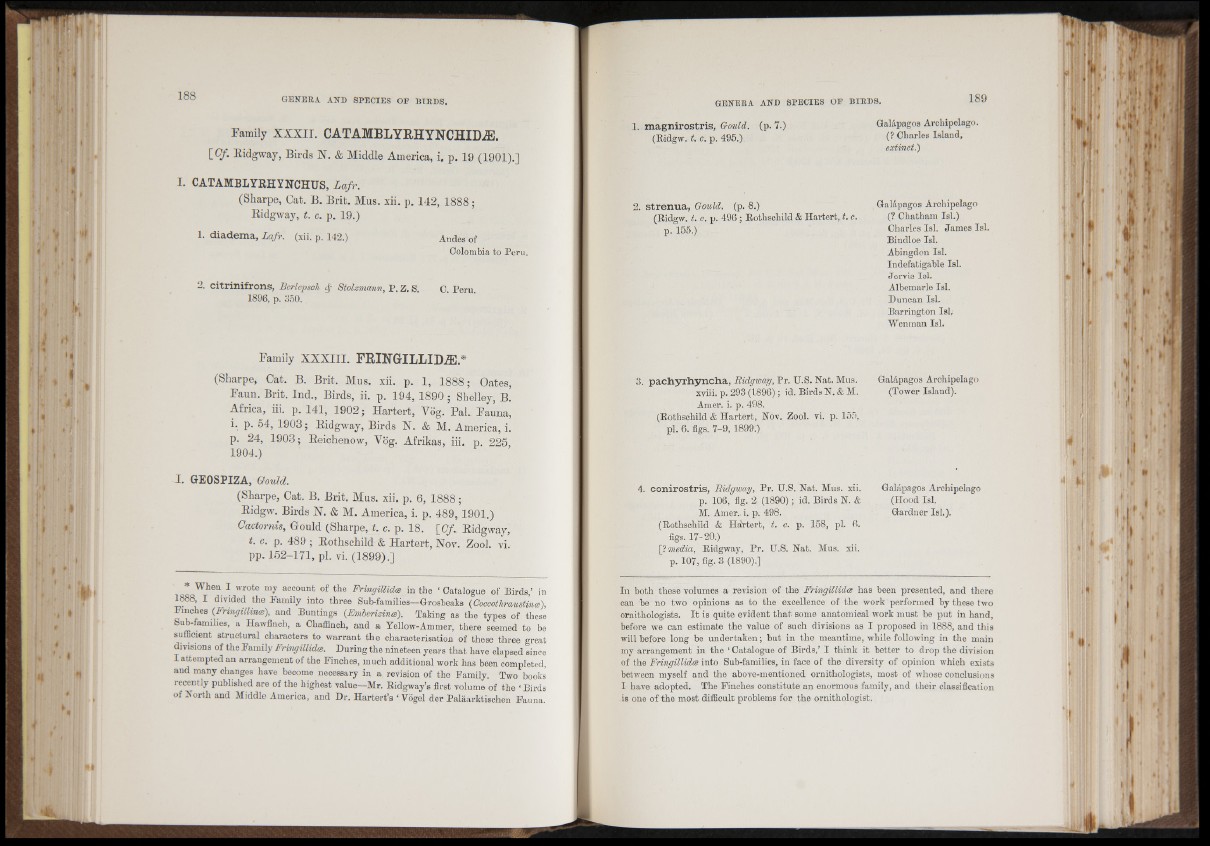
Family X X X II. C A T AM B LY R H Y N C H ID iE .
[ Of,. Eidgway, Birds N. & Middle America, i, p. 19 (1901).]
I. CATAMBLYRHYNCHUS, La.fr.
(Sharpe, Cat. B. Brit. Mus. xii. p. 142, 1888 j
Ridgway, i. c. p. 19.)
1. d ia d em a , Lafr. (xii. p. 142.) Andes of
Colombia to Peru.
2. c itr in if ro n s , Berlepsch Stolemann, P. Z. S. C. Peru.
1896, p. 350.
Family X X X III. F R IN G IL L ID iE *
(Sharpe, Cat. B. Brit. Mus. xii. p. 1, 1888; Oates,
Faun. Brit. Ind., Birds, ii. p. 194, 1890 ; Shelley, B.
Africa, in. p. 141, 1902; Hartert, Yog. PaL Fauna,
i. p. 54, 1903; Eidgway, Birds N. & M. America, i.
p. 24, 1903; Eeichenow, Vog. Afrikas, iii. p. 225
1904.)
I . GE0SPIZA, Gould.
(Sharpe, Cat. B. Brit. Mus. xii. p. 6, 1888;
Eidgw. Birds N. & M. America, i. p. 489,1901.)
Cactomis, Gould (Sharpe, t. c. p. 18. [O/. Eidgway,
t. c. p. 489 ; Eothschild & Hartert, Nov. Zool. vi.
pp. 152-171, pi. vi. (1899).]
* When I wrote my account of the FringiUidcs in the ‘ Catalogue of Birds,’ in
1888, I divided the Family into three Sub-families—Grosbeaks (OoccothrausUnee),
Finches (Fringillinm), and Buntings (Emherizince). Taking as the types of these
Sub-families, a Hawfinch, a Chaffinch, and a Yellow-Ammer, there seemed to be
sufficient structural characters to warrant the characterisation of these three great
divisions of the Family Fringillidw. During the nineteen years that have elapsed since
I attempted an arrangement of the Finches, much additional work has been completed,
and many changes have become necessary in a revision of the Family. Two books
recently published are of the highest value—Mr. Eidgway’s first volume of the ‘ Birds
of North and Middle America, and Dr. Hartert’s 1 Vogel der Palaarktischen Fauna.
1. m a g n iro s tr is , Gould, (p. 7.)
(Eidgw. t. c. p. 495.),
Galápagos Archipelago.
(? Charles Island,
extinct.)
2. s t r e n u a , Gould, (p. 8 .)
(Eidgw. t. c. p. 496 ; Eothschild & Hartert, t. c.
p. 155.)
Galápagos Archipelago
(? Chatham Isl.)
Charles Isl. James Isl.
Bindloe Isl.
Abingdon Isl.
Indefatigable Isl.
Jervis Isl.
Albemarle Isl.
Duncan Isl.
Barrington Isl,
3. p a c h y r h y n c h a , Eidgway, Pr. U.S. Nat. Mus. Galápagos Archipelago
xviii. p. 293 (1896); id. Birds N. & M. (Tower Island).
Amer. i. p. 498.
(Eothschild & Hartert, Nov. Zool. vi. p. 155,
pi. 6. figs. 7-9, 18990
4. c o n iro s tris , Eidgway, Pr. U.S. Nat. Mus. xii.
p. 106, fig. 2 (1890); id. Birds N. &
M. Amer.. i. p. 498.
(Eothschild & Hartert, t. c. p. 158, pL 6.
figs. 17-20.)
\l media, Eidgway, Pr. U.S. Nat. Mus. xii.
p. 107, %. 3 (1890).]
Galápagos Archipelago
(Hood Isl.
Gardner Isl.).
In both these volumes a revision of the Fringillidcc has been presented, and there
can be no two opinions as to the excellence of the work performed by these two
ornithologists. I t is quite evident that some anatomical work must be put in hand,
before we can estimate the value of such divisions as I proposed in 1888, and this
will before long be undertaken; but in the meantime, while following in the main
my arrangement in the ‘ Catalogue of Birds,’ I think it better to drop the division
of the FringilUdce into Sub-families, in face of the diversity of opinion which exists
between myself and the above-mentioned ornithologists, most of whose conclusions
I have adopted. The Finches constitute an enormous family, and their classification
is one of the most difficult problems for the ornithologist.